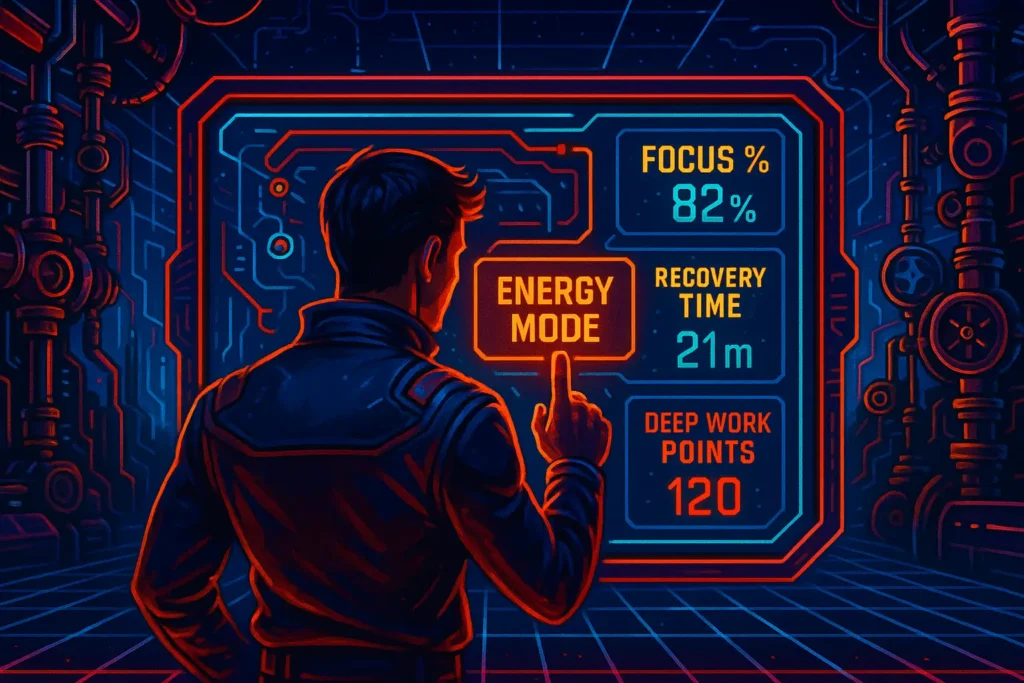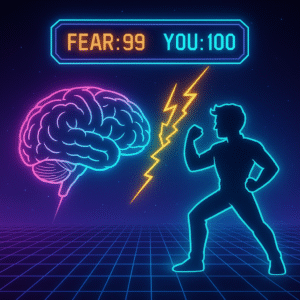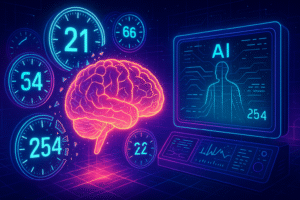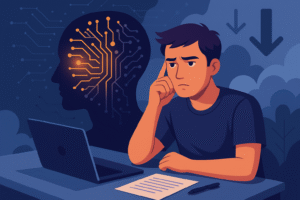How to be productive when everything around you seems designed for distraction? Here’s a reality check: Research shows that people check email every 6 minutes and social media every 12 minutes during work hours. Yet productivity experts keep pushing strategies that ignore this modern reality.
I discovered this gap through my own productivity struggles. As someone managing multiple projects while dealing with focus challenges, I tried every system imaginable. Time-blocking, Getting Things Done, the Pomodoro Technique – each worked brilliantly for about two weeks before I’d slip back into old patterns.
The breakthrough came when I realized something crucial: most productivity advice treats everyone identically, but peak performance is deeply personal. What transforms one person’s efficiency might completely disrupt another’s natural rhythm.
This guide reveals a practical system that works with your unique patterns instead of against them. You’ll discover how to become more productive and motivated by building habits that feel natural, not forced.
What You’ll Master:
- Why traditional productivity methods fail (and what actually works)
- The 3 core principles that make any productivity system sustainable
- How to design habits that align with your natural energy patterns
- A simple framework to become more efficient without burning out
- Real examples of productivity transformations using this approach
Why Most Productivity Systems Fail
Here’s a puzzling question: Why do 87% of productivity systems get abandoned within 30 days, despite initial enthusiasm and apparent success?
The answer reveals what I call The Productivity Paradox – the more complex your system, the less likely you are to maintain it. This leads to three critical mistakes most people make:
The Efficiency Trap
Traditional productivity advice focuses on doing more things faster. But how to be more efficient isn’t about speed – it’s about alignment. Consider this: A study found that people produce 3x more output when their tasks align with their natural energy peaks compared to working against their rhythms.
Most systems ignore individual patterns:
- Some people think best in morning silence, others need afternoon chaos
- Creative types often need unstructured time, while analytical minds prefer detailed schedules
- Introverts recharge through solo work, extroverts through collaboration
The Motivation Myth
Perhaps the biggest misconception is that sustainable productivity comes from willpower and motivation. Research from Duke University shows that 45% of our daily actions are habits, not conscious decisions.
When productivity depends on daily motivation, it inevitably fails. When it flows from well-designed systems that make efficient choices automatic, it becomes practically effortless.
The One-Size-Fits-All Problem
Generic productivity advice treats everyone like identical machines:
- “Wake up at 5 AM for maximum output”
- “Always tackle your hardest task first”
- “Use time-blocking to manage your schedule”
But how to become more productive varies dramatically based on your:
- Circadian rhythms and energy cycles
- Cognitive strengths and processing preferences
- Environmental factors and lifestyle constraints
- Personality traits and motivation triggers
This is why personalization matters more than perfection.
The 3 Core Principles of Sustainable Productivity
Before diving into implementation, let’s establish the research-backed foundations that make any productivity system effective. Understanding these principles ensures your approach builds on solid scientific ground.
Energy Management Over Time Management
The most counterintuitive productivity insight: managing energy matters infinitely more than managing time.
A Harvard Business Review study tracking 20,000 professionals found that peak performers focus on energy optimization rather than time optimization. They discovered that 90 minutes of high-energy focused work often produces more results than 4 hours of low-energy scattered effort.
How to become more productive and motivated starts with understanding your personal energy architecture:
Physical Energy Patterns:
- When does your body naturally feel most alert?
- What times of day make concentration feel effortless?
- How do different foods, activities, and environments affect your energy?
Mental Energy Cycles:
- When does complex thinking feel easiest?
- What types of tasks energize vs. drain your focus?
- How long can you maintain deep concentration before needing a break?
Success Habit: Track your energy levels every 2 hours for one week using a simple 1-10 scale. Note what you were doing, where you were, and how you felt. This creates your personal energy map for optimal task scheduling.
Related Article: Stages of Burnout
Friction Reduction Through Environment Design
Productivity isn’t about willpower – it’s about designing environments that make good choices automatic.
MIT research shows that environmental cues trigger 45% of our daily behaviors unconsciously. This means your physical and digital spaces heavily influence your productivity without you realizing it.
Friction Reduction Strategies:
Physical Environment:
- Keep important tools within arm’s reach during work hours
- Remove distractions from your line of sight
- Create dedicated spaces for different types of work
- Use visual cues to trigger productive behaviors
Digital Environment:
- Turn off non-essential notifications during focused work
- Use website blockers during deep work sessions
- Keep productivity tools easily accessible
- Organize files and folders for quick retrieval
Success Habit: Spend 15 minutes each evening preparing your workspace for tomorrow’s most important task. This eliminates decision fatigue and creates momentum from the moment you start working.
Progressive Habit Building
Sustainable productivity comes from building systems gradually, not making dramatic overnight changes.
Research from Stanford’s Behavior Design Lab reveals that habits lasting longer than 6 months start with actions taking less than 2 minutes. The key is beginning so small that consistency feels effortless, then gradually expanding.
The Progressive Building Framework:
First Two Weeks: Foundation
- Choose one small productivity habit
- Focus purely on consistency, not performance
- Celebrate showing up, regardless of results
3rd and 4th Week: Expansion
- Gradually increase duration or complexity
- Add supporting elements to strengthen the habit
- Address obstacles as they arise
5th to 8th Week: Integration
- Connect the habit to existing routines
- Layer in additional productivity elements
- Monitor results and adjust as needed
Success Habit: Start with just 15 minutes of focused work at the same time each day. Once this feels automatic (usually 2-3 weeks), gradually expand to 25 minutes, then 45 minutes.
Related Article: What are Keystone Habits
How To Be More Efficient: Building Your Personal Productivity System
Now let’s create a productivity approach tailored specifically to you. The key to lasting change isn’t following someone else’s blueprint – it’s designing your own system based on your unique patterns and preferences.
Step 1: Assess Your Productivity Profile
Understanding your current patterns is crucial for designing effective improvements. Use this AI-powered assessment to identify your productivity DNA:
AI PROMPT TO COPY/PASTE:
“I want to understand my productivity patterns to design a personalized system. Please act as a productivity specialist to help me identify my unique factors.
Please guide me through this assessment step by step:
Step 1: Energy Pattern Analysis 1. What time of day do you feel most mentally sharp and focused? Example: “I’m usually most alert between 9-11 AM and feel sluggish after 3 PM” 2. What activities or environments make you feel most energized? Example: “I work best in quiet spaces with natural light and feel drained in noisy, crowded areas” 3. How long can you maintain deep focus before needing a break? Example: “I can concentrate intensely for about 45 minutes, then need a 10-minute break”
Second Step: Challenge Identification 1. What specific obstacles consistently disrupt your productivity? Example: “I get distracted by notifications and struggle when multiple tasks feel equally urgent” 2. Which types of tasks do you tend to avoid or procrastinate on? Example: “I delay writing reports but handle emails quickly” 3. What situations make you feel most overwhelmed? Example: “When I have back-to-back meetings with no time to process between them”
Third Step: Lifestyle Integration 1. What are your non-negotiable daily commitments? Example: “School pickup at 3 PM, gym on Tuesday/Thursday evenings” 2. What does your ideal productive day look like? Example: “Starting with creative work, handling admin in the afternoon, ending with planning tomorrow”“*
Example Assessment Conversation:
AI: “What time of day do you feel most mentally sharp and focused?”
User: “Definitely mornings between 8-10 AM. I can tackle complex problems easily then, but by 2 PM I’m only good for routine tasks.”
AI: “That’s a clear pattern. What activities or environments make you feel most energized?”
User: “I work best with my door closed, noise-canceling headphones, and a clean desk. Open offices completely drain me.”
AI: “Excellent insights. Your profile suggests you’re a morning-peak producer who needs controlled environments. Let’s identify what disrupts this natural flow. What specific obstacles consistently disrupt your productivity?”
This assessment reveals your unique productivity patterns hence, making it easier to design habits that work with rather than against your natural tendencies.
Step 2: Design Your Core Productivity Habits
Based on your assessment, focus on building 2-3 core habits that address your biggest challenges while leveraging your strengths. How to become more productive and motivated depends on creating habits that feel natural and rewarding.
The 3 Essential Productivity Habits:
First Habit: Peak Energy Protection Reserve your highest energy time for your most important work. This means:
- Identifying your 2-3 hour peak energy window
- Blocking this time for deep, focused work only
- Protecting it from meetings, emails, and interruptions
- Using lower energy times for routine tasks
Second Habit: Distraction Management Create boundaries that preserve your focus without feeling restrictive:
- Turn off notifications during focused work blocks
- Keep your phone in another room or drawer
- Use website blockers for social media during work hours
- Create a “capture system” for random thoughts and ideas
Third Habit: Energy Recovery Build in strategic recharge periods to maintain sustained productivity:
- Take 5-10 minute breaks every 45-60 minutes
- Include physical movement or fresh air when possible
- Practice brief mindfulness or breathing exercises
- End each work session by planning the next one
Step 3: Implementation Strategy
The key to making these habits stick is starting small and building gradually. Research shows that sustainable behavior change happens when new habits feel almost effortlessly easy.
1st and 2nd Week: Foundation Building
- Choose just ONE habit to focus on
- Start with the minimum viable version (15-20 minutes)
- Focus purely on consistency, not performance
- Track completion, not quality
3rd and 4th Week: Gradual Expansion
- Increase duration by 10-15 minutes
- Add supporting elements (better environment, tools)
- Begin connecting the habit to existing routines
- Address obstacles as they arise
5th to 8th Week: System Integration
- Layer in your second productivity habit
- Create smooth transitions between focused and routine work
- Develop contingency plans for disrupted days
- Fine-tune based on what’s working best
Example Implementation:
Sarah, a marketing manager, implemented her Peak Energy Protection habit like this:
Week 1: 30 minutes of uninterrupted work from 9:00-9:30 AM Week 2: Extended to 45 minutes (9:00-9:45 AM)
Week 3: Added phone-free environment and email blocking Week 4: Expanded to 60 minutes with transition ritual Week 6: Layered in afternoon energy recovery breaks
Result: 40% increase in important project completion within 8 weeks
Advanced Productivity Optimization
Once your core habits feel automatic, you can optimize for even greater efficiency. How to be more efficient at an advanced level involves fine-tuning your system based on performance data.
Energy-Task Matching
Align different types of work with your natural energy rhythms:
High Energy Tasks (Peak Hours):
- Creative problem-solving
- Strategic planning
- Complex analysis
- Important decision-making
Medium Energy Tasks (Steady Hours):
- Routine communication
- Data entry and organization
- Meeting participation
- Project coordination
Low Energy Tasks (Recovery Hours):
- Email processing
- Calendar management
- File organization
- Research and reading
Batch Processing for Efficiency
Group similar tasks together to minimize cognitive switching costs:
Communication Batching:
- Check email 2-3 times daily at set intervals
- Schedule all phone calls within 1-2 hour blocks
- Group meetings on specific days when possible
Decision Batching:
- Make routine choices in advance (clothes, meals, routes)
- Create templates for repetitive tasks
- Establish clear criteria for common decisions
Administrative Batching:
- Handle all paperwork and forms once weekly
- Process expenses and invoicing monthly
- Review and update systems quarterly
Real-Life Transformation: How to be Productive
Let me share how Marcus, a software team lead, used this system to transform his productivity while managing both technical work and team responsibilities.
The Starting Point
Marcus struggled with:
- Constant interruptions from team members needing help
- Important architecture work getting pushed aside for urgent requests
- Working late nights to catch up on strategic projects
- Feeling like he was always reactive, never proactive
The Assessment Results
Energy Patterns: Peak focus 7-10 AM, steady energy 10 AM-2 PM, low energy after 3 PM Major Challenges: Interruptions, lack of boundaries, mixing strategic and tactical work Lifestyle Factors: Remote work flexibility, daily standups at 10 AM, family dinner at 6 PM
The Custom System
First Habit: Strategic Morning Block (7:00-9:30 AM)
- No Slack, email, or phone access
- Deep work on architecture and planning only
- “In Focus Mode” status with emergency contact info
Second Habit: Team Availability Windows
- Open for questions 10 AM-12 PM and 2-4 PM only
- Documented common solutions to reduce repeat questions
- Weekly office hours for complex problem-solving
Third Habit: End-of-Day Planning
- 15 minutes at 5 PM to plan tomorrow’s priorities
- Clear transition ritual between work and family time
- Quick wins list for low-energy moments
Results After 12 Weeks
Marcus’s transformation was remarkable:
- 70% increase in strategic project completion by protecting morning hours
- 50% reduction in interruption-related stress through clear availability windows
- Team satisfaction improved due to predictable support availability
- Eliminated evening work by maximizing high-energy productivity
- Promoted to senior architect role due to increased strategic contributions
Key Success Factors:
- Working with natural rhythms instead of fighting them
- Clear communication about availability and boundaries
- Gradual implementation that felt manageable, not overwhelming
- Regular adjustment based on what worked best
Marcus’s story shows how personalizing your approach makes productivity feel effortless rather than forced.
Common Challenges and Practical Solutions
Even with a personalized system, you’ll encounter obstacles. Here are the most common challenges and proven solutions:
Challenge 1: Inconsistent Energy Levels
Problem: Some days you feel energized, others completely drained.
Solution: Create flexible protocols for different energy states:
- High Energy Days: Tackle 2-3 important projects
- Medium Energy Days: Focus on 1 main project plus routine tasks
- Low Energy Days: Handle administrative work and planning only
Challenge 2: Unexpected Interruptions
Problem: Urgent requests derail your planned productivity.
Solution: Develop an “Interruption Protocol”:
- Assess: Is this truly urgent or just feels urgent?
- Defer: Can this wait until your next availability window?
- Delegate: Could someone else handle this appropriately?
- Do: If genuinely urgent, handle it quickly and return to your plan
Challenge 3: Perfectionism Paralysis
Problem: Wanting everything perfect prevents starting or finishing tasks.
Solution: Embrace “Good Enough” standards:
- Set completion criteria before starting any task
- Use timeboxing to limit perfectionist tendencies
- Focus on progress over perfection
- Remember: done is better than perfect
Challenge 4: System Overwhelm
Problem: Your productivity system becomes more complex than helpful.
Solution: Regular simplification reviews:
- Monthly: What’s working vs. what’s adding unnecessary complexity?
- Quarterly: Which habits provide 80% of your productivity gains?
- Annually: How has your ideal workflow evolved?
Conclusion: How to Be Productive
How to be productive isn’t about following the latest productivity guru’s system or downloading another app. True productivity comes from understanding your unique patterns and designing habits that work with your natural tendencies.
The approach we’ve explored gives you the framework to:
- Identify your personal productivity patterns through systematic assessment
- Design habits that align with your energy, preferences, and lifestyle
- Implement changes gradually using proven behavior change principles
- Optimize continuously based on real-world results
Remember, how to become more productive and motivated isn’t about perfection – it’s about progress. The most successful people aren’t those who work hardest; they’re those who design systems that make important work feel natural and sustainable.
The transformation you’ve been seeking isn’t about changing who you are – it’s about creating systems that help you become who you’re capable of being.
Take Your Productivity to Next Level!
Everything you just discovered about personalized productivity? That’s exactly what the AI Habits Coach was built to deliver – but with a game-changing twist.
While this blog gave you the framework for understanding your unique patterns, our AI-powered platform takes it to the next level by automatically personalizing habit recommendations based on your assessment, then gamifying the entire journey to make consistency feel effortless and fun.
Instead of manually tracking energy levels and building habits through willpower, the Moore Momentum System creates an ethically addictive experience that works with your brain’s natural dopamine systems. You’ll get the same science-backed approach to energy management, friction reduction, and progressive habit building – but wrapped in a rocket-themed adventure that makes personal growth feel like playing your favorite game.
The system addresses not just productivity, but all 5 Core Areas of Life (Mindset, Career & Finances, Relationships, Physical Health, and Emotional & Mental Health) through the same personalized approach you just learned about. Because true productivity isn’t just about work efficiency – it’s about creating momentum that ripples across every aspect of your life.

